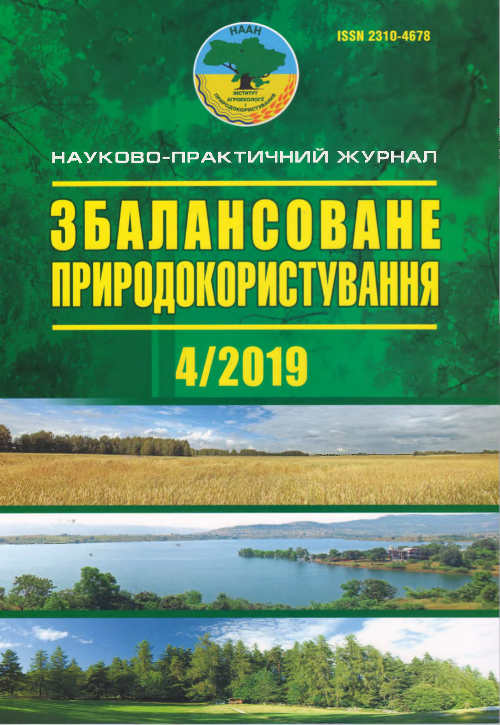MYCOBIOM OF RASPBERRY PLANTS` ORGANS OF VEGETATION BY INFLUENCE OF VARIETY AND NEW FERTILIZERS IN ORGANIC PRODUCTION
DOI:
https://doi.org/10.33730/2310-4678.4.2019.199076Keywords:
raspberry plant, vegetative organs of plants, organic fertilizers, micromycetes, the number of CFUs, phytopathogens, organic productionAbstract
In this article were investigated the species composition and abundance of micromycetes in the mycobiom of the vegetative organs of raspberry plants, depending on the variety, organic fertilizer VITERI and its composition with essential oils. Found in the mycobiom of plants of the varieties of raspberries Joan Jay and Himbo-Top are dominated by fungi: Septoria rubi, West, Botrytis cinerea, Pers, Aspergillus niger, V. Tiegh, Alternaria alternata, (Fr.) Keissl., Fusarium sp. regardless of the phase of plant ontogenesis. These micromycetes are producers of mycotoxins and are characterized by different mechanisms of influence on living organisms and they are a powerful factor in the biological contamination of agroecosystems and reducing the biosafety of plant products. Essential oils and their compositions with organic fertilizer VITERI greatly affect the abundance and biodiversity of micromycetes on the vegetative organs of raspberry plants. In case of the foliar treatment with organic fertilizer VITERI with the addition of Basil essential oil shows a stabilizing selection in the mycobiota of the vegetative organs of the raspberry plants Joan Jay and Himbo-Top in the phase of intense fruiting.
References
Masaiuky Sekizura, Tszyn Vej Tsy, Tokhpy Aomori, Yuko Okada, Katsunori Nakamura, Takia Apaki, Riuia Khoriuchi, Shyn Okhty, Tonomori Nakamura i Kouirou Yamamoto (2014). Effect of a Dietary Supplement Containing Raspberry Ketone on Cytochrome P450 3A Activity. Faculty of Pharmacy of Такаsакі University of helth and social care. 37-1 Nakaoorui-machi. Такаsакі, Huмма, Japan. Pharmaceutica Analytica Acta. Pub Med Journals (???).
Shiow Y. Wang and Hsin-Shan Lin (2000). Antioxidant Activity in Fruits and Leaves of Blackberry, Raspberry and Strawberry Varies with Cultivar and Developmental Stage. Fruit Laboratory, Beltsville Agricultural Research Centre, Agricultural Research Service. U. S. Department of Agriculture, Beltsville. Maryland 20705. J. Agric. Food Chem. 48 (2): 140–146. Chemical Abstracts (???).
Hvozdiak R.I., Pasichnyk L.A., Yakovleva L.M., Moroz S.M., Lytvynchuk O.O., Zhytkevych N.V., Khodos S.F., Butsenko L.M., Dankevych L.A., Hrynyk I.V., Patyka V.P. (2011). Fitopatohenni bakterii. Bakterial’ni khvoroby roslyn [Phytopathogenic bacteria. Bacterial diseases of plants]. Patyka V.P. (Ed.). Kyiv: TOV NVP Interservis. 1: 444 (In Ukr.).
Malynovs’ka I.M. (2017). Vplyv orhanichnoho i mineral’noho udobrennia na chysel’nist’ ta fiziolohobiokhimichnu aktyvnist’ mikroorhanizmiv siroho lisovoho hruntu [Influence of organic and mineral fertilizer on the number and physiological and biochemical activity of microorganisms of gray forest soil]. Problemy ekolohichnoi biotekhnolohii, 2. URL: http://ecobio.nau.edu.ua/index.php/ecobiotech/ article/view/12194/16294 (In Ukr.).
Markova I.L. (2017). Fitopatolohiia [Phytopathology]. Markova I.L. (Ed.). Kyiv: Lira-Kiev, 480. (In Ukr.).
Dudka I.A., Vasser S.P., Jellanskaja I.A. i dr. (1982). Metody jeksperimental’noj mikologii [Methods of experimental mycology]. Bilaj V.I. (Ed.). Kiev: Naukova dumka: 548. (In Rus.).
Zvjagincev D.G. (1991). Metody po4vennoj mikrobiologii i biohimii [Methods of soil microbiology and biochemistry]. Zvjagincev D.G. (Ed.). Moscow. MSU. 304. (In Rus.).
Parfeniuk A.I.; Sterlikova O.M.; Blahinina A.A. et al. (2014). Ekolohichne otsiniuvannia sortiv pshenytsi za vplyvom na formuvannia populiatsij fitopatohennykh hrybiv [Ecological evaluation of wheat varieties by influence on the formation of populations of phytopathogenic fungi]. Kyiv: 39. (In Ukr.).
Polianchykov S., Kapitans’ka O. (2017). Pozakoreneve pidzhyvlennia: mozhlyvosti i pomylky [Root feeding: opportunities and mistakes]. Polianchykov S. (Ed.). Ahroindustriia. 9: 32–36. (In Ukr.).
Gadzalo Ja.M., Patyka N.V., Zarishnjak A.S. (2015). Agrobiologija rizosfery rastenij [Agrobiology of plant rhizosphere]. Кiev: Agrarna nauka. 386. (In Rus.).
Kudejarova E.I. (1999). Raznoobrazie mikrobnyh soobschestv pri razli4nyh antropogennyh nagruzkah [Diversity of microbial communities under different anthropogenic loads]. Kishinev: Vyshaja shkola. 273. (In Rus.).
Nannipieri P., Ascher J., Ceccherini M.T (2003). Microbial diversity and soil functions. European Journal of Soil Science. 54: 655–670.
Levitin M.M. (2009). Fitopatogennye griby i blagosostojanie 4elove4estva [Phytopathogenic fungi and human well-being]. URL: http://mycol-algol.ru/event_00001/Levitin_event00001.pdf (date of accesse: 04.05.2019) (In Rus.).
Downloads
Published
Issue
Section
License
- The authors reserve the right to authorship their work and pass the journal the right to publish this work under a Creative Commons Attribution License license, which allows other persons to freely distribute the published work with the obligatory The authors of the original work and the first publication of this magazine.
- The authors have the right to make independent additional agreements on the nonexclusive dissemination of the work in the form in which it was published by this magazine (for example, to post work in the company's electronic storage or to publish as a monograph) , subject to the first publication of the link to this journal.
- Journal policy allows and encourages the placement of authors on the Internet (for example, in the repositories of institutions or on personal websites) manuscript work as to the presentation of this manuscript to the editorial board and during its editorial processing, as it contributes to The productive scientific discussion and positively affects the efficiency and dynamics of citation published work (see The Effect of Open Access).


